2001.09.21 18:02
metabolic/delivery, etc.
In the recent Barbara Flanagan article in Metropolis on Venturi and Scott Brown it states:
And when Venturi envisions an electronic "facade of glittering information," the inevitable political question (what does it say and who decides?) can be a vexing one. "What the message is I don't know, and I'm not too ashamed of not knowing," Venturi says. "Content is not the architect's job."
I think Venturi here admits his most present flaw, and even goes on to make a big mistake about the future. As the architect of the first online virtual museum of architecture, I see content as very much the job of the architect.
Can it be said that precisely attacking flaws engenders paradigm shifts?
Kind-of like going into a black hole and then being in the other side.
2001.09.28 10:53
11 Sept. 2001 considered chronosomatically
0. re-read "The Gauge" and "(chronosomatically) Contemplating the Navel."
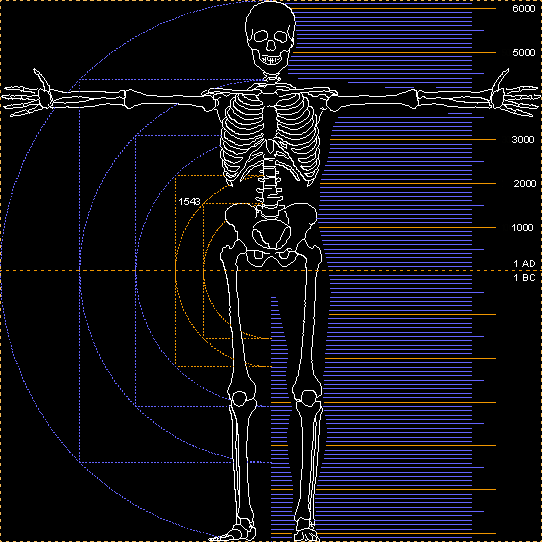
1. Note that 2001 AD slices through the body at the lowest tips of the rib cage. Note also that the top-most edges of the hip bones correspond with the early years of global exploration (e.g., Magellan's global circumnavigation in 1521).
2. Roughly the last 500 years correspond to that part of the body where there is no skeleton along the corporal periphery (only the spinal column in the background). This corporal hiatus is also where the body most readily and freely expands.
3. Within the Timepiece notes, the new and sudden appearance of the tips of the rib cage mark the beginning of the end of humanity's unrestricted expansion. Additionally, the polarized duality of the rib cage tips mark new polarized extremes within humanity. Moreover, the new corporal extremes are indeed structural, if not also ultimately protective.
4. "(chronosomatically) Contemplating the Navel" relates the historical events that correspond with the slice of the body that simultaneously cuts through the upper-most edge of the hip bones and the navel. The events of 11 September 2001 (particularly, and with full ironic inversion of unrestricted expansion, the dual implosions of the World Trade Center) correspond with the slice of the body where both lowest tips of the rib cage are now firmly and simultaneously present.
5. There is much hope for the future of humanity in that the rib cage gradually manifests a strong and protective structural network, even thought oblique opposite-ness is also part of the make-up. Ultimately, however, the rib cage forms a full ring when it reaches the same level as the heart (approximately 1100 years from now).
According to chronosomatics, what has changed for humanity since 11 September 2001 is that the era of completely unrestricted expansion has come to its 'corporeal' limits. The notion of more and more forthcoming peripheral limits, however, is something that humanity (especially the "West") cannot deny.
| |
2001.11.30
ideas
8. “Notes from Underground” -- Piranesi was best at manifesting double theaters. The prisons are really what he didn’t find, but clearly imagined he might have found (wanted to find?). Piranesi simply re-presented those images that presented a tortuous nature within his imagination. He himself was not tortured, however, because the Prisons are what he did not find. All the rest of his oeuvre is what he did find, and his work toward the end is his completely untortured imagination. The second state of the Prisons is a further affirmation of what he did not find. This is absolutely great for starting TX2 at architecthetics. As fate would have it, we today are actually finding what Piranesi actually didn’t find. Could it be that architects of the future will find themselves dealing more and more with a built environment that manifests a double theater of “prisons” both below and above ground?
2002.01.07 19:21
imitation?
What happened at Tampa, Florida is something that precisely enacts a confusion of reenactment and imitation. It is a tragedy, of course, but, unfortunately not one without design (and here high rise buildings fit very much into the overall design).
What your stance plainly demonstrates is just how much "modern" humanity has been trained/brainwashed into understanding virtually all imitation as that which completely lacks "design with imagination," as you put it. The irony here, however, is that our imaginations are already reenactments of our corporal physiologies. Another irony is that the greater part of "design" today is indeed "just trying to copy with miserable tools." At the very least, nothing you said is altogether innovative, especially among modern designers. Just redundant, as you yourself conveniently note.
I am quickly reminded of the following passage from Charles Hedrick, History and Silence:
"In the modern world, present circumstances are conceived in terms of a projected future. What we are depends on where we are going, not where we have been. To the extent that the power of the past is acknowledged at all, it is seen as a burden, as an impediment to progress and self-realization, as something to be overcome. By contrast, traditional societies look much more to the past for the determination of who and what they are: hence the ancient prestige of the genre of history."
2002.01.07 19:53
Re: i-mac-thematica?
What exactly is so good about the design of a product, in this case the "new" iMac, that manifests the wholesale continuance of planned obsolescence? Something that exists almost entirely for the purpose of making "the same" something obsolete, and hence disposable, should not be considered "good design".
But if you insist on it, i.e., the new iMac, being good design, then you automatically also have to concur that today's iMac is the near future's trash. Yes, good design today almost always becomes trash.
2002.04.04 17:22
Re: What is Design List?
Speaking (momentarily) as only an artist, for me it is the doing of art, the "creating" of it that is the utmost delight. And the more delight you're receiving while doing it, chances are more it's really good art. And, if you find others that also delight in what delights you, then the delight simply multiplies.
Now, speaking as only a virtual architect (of Quondam and Museumpeace), all I really want is for everyone to freely use and enjoy my virtual architectural creations, but please provide your own firmness (and, ok, provide your own infirmities if that's how you're wired).
Now back to being only an artist--you know, I think slapdash is probably one of the only really modern styles. Just thinking about slapdash Papal art all over the Vatican triggers a gush of drives and juices. Umm! Boy were those crab cakes and wild rice good today. And, as my fraternal schizophrenic often proves, they can read apposing minds, and even sometimes apposing futures.
2002.04.14 15:00
Re: history lesson?
Thank God the future is never set in stone.
2002.04.25 11:53
Re: more tools talk
Like most other recent articles and essay regarding architecture vis-a-vis digital technologies, Peter Evans' "Exploring a Virtual Future" appears to be completely unaware of what effect digital technologies were having on (certain) architects much prior to the mid 1990s and thereafter.
How can anyone question or suggest what is "appropriate" without knowing at least the larger extent of the situation? In this case, a situation that goes back well before the current computerized workings of Gehry and Eisenman.
Just my immediate thoughts on how some 'history' is often presently not what really did happened.
2002.09.18 12:54
Re: what is an architectural idea?
Perhaps the real question is "What idea is an architecture?"
2002.10.16 11:47
art and architecture 30 years ago
The scaffolded facade of Milan Cathedral. A sign of the future of pre-Modern architecture
2002.11.07 12:35
Re: on Charlie Rose tonight
Bill Gates Chairman / Chief Software Architect, Microsoft
future occupations?
Chief Hardware Architect
Chief Building Architect
Chief Unbuilding Architect
Chief Architect's Architect
Chief War Architect
Chief Peace Architect
Chief Chief Architect
Chief Lifestyle Architect
Chief Spin Architect
Chief Surgical Architect
Chief Genetic Architect
Chief Architect of the Arts
Chief Architect of the Law
Chief Architect of Perpetual Consumption
Chief Architect of Trash
Chief Funeral Architect
2002.11.21 14:04
what a difference 250 years make
Well, I did make a pilgrimage this morning down to Ridge Avenue and Buttonwood Street, Philadelphia, where "legend" has it that Benjamin Franklin flew a kite with key and discovered that lightening and electricity are the same thing 250 years ago. Although in an area still full of a lot of old warehouses, many now facilitating Chinese/Oriental businesses relative to Chinatown several blocks south, the "historic site" is an otherwise somewhat decrepit part of the city. There actually is an empty lot just east of Ridge Avenue on Buttonwood Street, and that's what I took pictures of. Otherwise, there is nothing at all to suggest that something of quite modern significance ever happen at this place, except perhaps the rather large outdoor electrical power station enclosed within a high chain-link fence a half block south on the other side of Ridge Avenue.
I had somewhat heightened expectations of my visitation since deciding to go yesterday morning. Last night I was watching a movie over a friends place, and I asked, "Do you know where Buttonwood Street is. I think it's right around Ridge and Spring Garden." My friend didn't have any idea, but offered me a SEPTA (Southeastern Pennsylvania Transportation Authority) map. I found Buttonwood Street a block south of Spring Garden Street, and I thought I actually knew the site because I thought it was where a building I finally photographed this past February was. This building/warehouse is one I've known since my college days, and I always admired it because of its facade's striking similarity with the facade of Venturi and Rauch's D'Agostino House (1968, unbuilt). I then found myself even wondering whether Venturi actually knew this warehouse because, just maybe, Venturi had once gone to make his own pilgrimage to Ridge and Buttonwood. Alas, the warehouse I know is not at Ridge and Buttonwood, rather at a similar intersection with Ridge Avenue a block north of Spring Garden Street. It should be noted that Ridge Avenue is one of Philadelphia's old zig-zagging diagonal streets in contrast to the otherwise planned grid of streets, off the grid because it follows an old "Indian" trail, and in Franklin's time was the main route out of town to the north-western countryside.
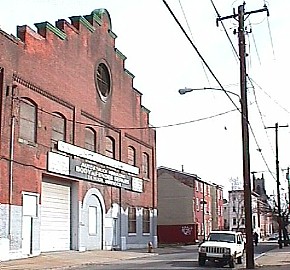 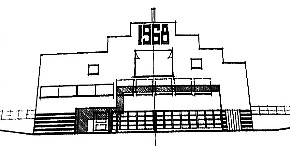
I now find myself wondering what all this "says" about us in the beginning of the 21st century, a people so reliant on electricity, yet otherwise largely oblivious to how we got that way. There is a tiny triangular block just south of the empty lot on Buttonwood Street with a small used-car business on it. I knocked on the office door, and a tall black Muslim (I assume by his garb) man in his thirties answered. I asked him if heard of the story of Benjamin Franklin flying a kite and "discovering" electricity. He said, "I don't think I ever heard dat." I told him Franklin did it here over 200 years ago. He said, "What? In dis building?" I said, "No. Like over there." Then he asked in a kind of mean voice, "Why you sayin' all dis?" I then smiled, but I didn't say much more.
As I drove home up Broad Street I thought to myself in irony, "Well that was a swell way to celebrate Quondam's 6th anniversary." And then I thought, if that's what Franklin's kite flying site is like after 250 years, God only knows what Quondam will be 244 years from now.
2002.11.24 17:48
Re: what a difference 250 years make
You're kind of exactly right when you suggest that maybe there are too many places of "historic" significance in Philadelphia, and it is interesting that you bring to mind Piranesi and his map of the Campo Marzio because that map/plan indeed records so many of ancient Rome's historic sites even though almost none of them still existed in Piranesi's time. Moreover, it is worth also keeping in mind that Piranesi was delineating a place/city more than 1400 years after the fact. It seems almost impossible to even speculate whether, for example, the old "Indian" trail of Ridge Avenue will even still exist in 3402. Then again, it would be fun to imagine what some future Philadelphia Renaissance or Baroque period might be like. Note Franklin and Piranesi are near contemporaries; Piranesi died 1778 while Franklin was in France.
| |
2003.01.10 19:02
Re: the dead end of urbanism as we know it
Urbanism
Architecturism[?]
Spacism[?]
Check out Le Corbusier's plan for rebuilding Berlin (1958, a few years before the wall) at the end of volume 7 of the Oeuvre Complete. In retrospect, it is almost bizarre in its intentions. Note the reenactment of Chandigarh's Great Assembly next to the Reichstag! And the gigantic pronged towers scattered in the east. Urbanism, architecturism and spacism all in one plan.
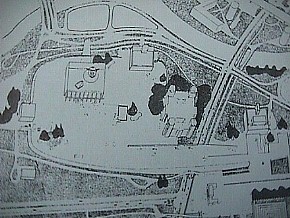
It's funny. I really like this plan, and would love to see it executed, but not at the cost of losing Berlin in the process. If Disney, for example, ever wants to (again) do a great thematic 'FutureTown' (they actually called it TomorrowLand, didn't they?) they should simply enact this plan, and maybe put a big wall around it. I think I'd even like to live there. A kind of beyond virtual Berlin, like a new double Berlin, again.
And here's something that's really interesting in its obscurity. Remember all those little sketches depicting bad modern building design that Leon Krier used to draw as contrast to his 'good' designs? I'm betting big money that Krier actually used the axonometric of Le Corbusier's Berlin plan (OC, vol. 7, p.234) as 'inspiration'. The 'lightening-bolt buildings just south of the Tiergarten are a dead give-a-way. Now I know why I always thought those sketches were actually the best buildings Krier ever designed.
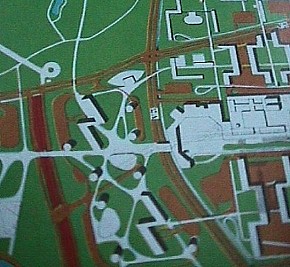 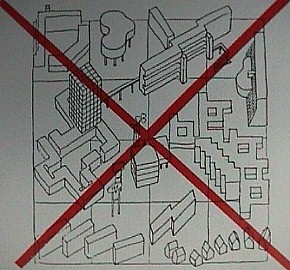
| |
2003.02.04
Unthinking an Architecture
Volumes of Unthinking an Architecture may include Remove, Lacunae, Nimiety, Sagacity, Chronosomatics, Atypical, Domestic, but not necessarily in that order. The order really doesn't matter. I'm thinking of UAA as a multi-part vehicle for product generation and placement. There is also the notion of being purposefully obsurant [toward absurd], thus allowing all kinds of non sequitors and an overall lack of presupposed cohesion.
2003.02.13 10:25
mixing things up
I wish museums mixed things up more. For example, I'd like to see Poons in a French period room, or Duchamp in a Ladies Room. Brancusi next to armour, why not? Museum as future-shock, sort of. Pick your destiny
Hold me! Thrill me! Kiss me! You're my pride and joy, etc. Now rearrange me.
2003.02.23 11:25
Re: Cremaster Cycle
Is it true that Barney is next going to work on a "reality TV" project? American Immunity Idol, is it? Or Quasi-Quondam Bachelor Fearlessly Stripping In Absolutely Fabulous Drag? I know, Lights, Camera, Apostasy!
In the future, all reality will be recorded by a camera, because if it isn't captured by a camera, you can kiss that reality goodbye.
[for lazy eyes only, if you can believe it:]
You should read about the Christian saints whose feasts coincide with Jewish Apostate Architecture Day, 20 February.
Ss. Tyrannio, Zenobius and Other Martyrs (A.D. 304 and 310) It's the Other Martyrs that are most interesting. According the Eusebius' eyewitness account, the wild beasts that these martyrs were fed to couldn't come near them. Looked like Divine intervention. Eusebius said so. He is a good historian, and good writer, and author of the only original (architectural)description of the Church of the Holy Sepulcher that we today have. I believe him.
St. Sadoth, Bishop of Seleucia-Ctesiphon, Martyr (c. A.D. 342) Those early Christians in Persia were asked to give succinct confession of doubt as well.
St. Eleutherius, Bishop of Tournai (A.D. 532) All the records pertaining to his life burned in the great fire that destroyed Tournai Cathedral in 1092. Today they say you should doubt that he raised the Governor's daughter from the dead. Of course, the legend tells us the young girl died because Eleutherius, as young bishop, did not return her affections. How do you mend a broken heart indeed. You gotta love this guy's name!
St. Eucherius, Bishop of Orleans (A.D. 743) A localized reenactment of the reluctant-Moses-syndrome.
St. Wulfric (A.D. 1154) "...it seems that it was for prophecy more than anything else that he was famous." I like the part about King Henry I and King Stephen being among Wulfric's visitors.
Bd. Elizabeth of Mantua, Virgin (A.D. 1468) "She is said to have prophesied her own death a year before it happened." "Extraordinary crowds attended her funeral."
2003.05.15 13:59
Re: Life in a real museum
Metabolism as a physiological function operates via equal measures of destruction and creation, i.e., catabolism and anabolism. The metabolic is a visceral destructive/creative human process.
Perhaps Venice should be reenacted like the caves with primitive painting in them. Make the original off limits and allow the tourists to visit the facsimile.
2003.06.24 10:50
in Kline's shadow
...is right about Warhol's Shadows bearing a relationship to Franz Kline's work, moreover, a relationship that should have been noted since Shadows came into being. Shadows of what I wonder, of Kline?
Warhol I know fairly well, however, Kline is now a whole new interest, (like Held is a new interest)..
As to Kline Shadow Test, let's just say I enjoy the combination of Kline and Warhol's sort of art via genetic engineering.
Remember pure cloning is nothing less than extreme reenactment. Imagine that, a future that is precisely something that actually once was. I quess it is true that reenactment likewise engenders an inversion.
|